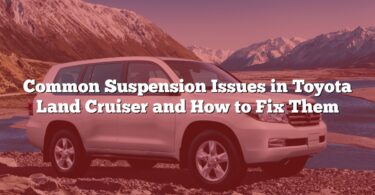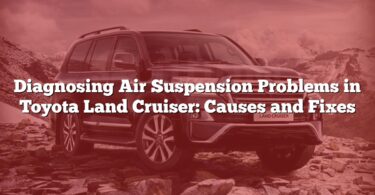Experiencing a sudden loss of electrical power in your Toyota Land Cruiser can be frustrating and inconvenient. This guide dives straight into the most common causes of electrical issues, from a dead battery to faulty wiring, and provides practical, easy-to-follow fixes. Whether you’re stranded on the road or troubleshooting at home, this article is your step-by-step companion to getting your Land Cruiser back on track.
Quick Troubleshooting Guide for Toyota Land Cruiser: 48 Problems and Solutions
| N° | Problem/Cause | Solution |
|---|---|---|
| 1 | Dead battery | Replace the battery. |
| 2 | Weak battery | Charge or replace the battery. |
| 3 | Corroded battery terminals | Clean the terminals and reconnect. |
| 4 | Faulty alternator | Replace the alternator. |
| 5 | Loose or damaged wiring harness | Inspect and repair or replace the wiring harness. |
| 6 | Blown fuses | Replace the blown fuse. |
| 7 | Faulty starter motor | Replace or repair the starter motor. |
| 8 | Malfunctioning ignition switch | Replace the ignition switch. |
| 9 | Defective ECU (Engine Control Unit) | Diagnose and replace or reprogram the ECU. |
| 10 | Faulty voltage regulator | Replace the voltage regulator. |
| 11 | Short circuit in the electrical system | Identify and repair the short circuit. |
| 12 | Damaged or corroded ground connections | Clean and tighten the ground connections. |
| 13 | Faulty relays | Test and replace the faulty relay. |
| 14 | Water damage to electrical components | Dry and repair or replace affected components. |
| 15 | Parasitic battery drain | Identify and eliminate the drain source. |
| 16 | Rodent damage to wiring | Repair or replace damaged wiring. |
| 17 | Overloaded electrical system | Reduce load or upgrade the electrical system. |
| 18 | Failed or degraded battery cells | Replace the battery. |
| 19 | Faulty alternator belt or tensioner | Replace the belt or tensioner. |
| 20 | Faulty auxiliary power sources (e.g., inverters) | Repair or replace the auxiliary power source. |
| 21 | Power surges or electrical spikes | Inspect and replace damaged components. |
| 22 | Faulty aftermarket electrical installations | Remove or repair poorly installed components. |
| 23 | Manufacturing defects in electrical components | Replace the defective components. |
| 24 | Fuel pump failure | Replace the fuel pump. |
| 25 | Clogged fuel filter | Replace the fuel filter. |
| 26 | Malfunctioning fuel injectors | Clean or replace the fuel injectors. |
| 27 | Faulty mass airflow sensor (MAF) | Clean or replace the sensor. |
| 28 | Glow plug issues (diesel-specific) | Replace the glow plugs. |
| 29 | Faulty spark plugs (petrol-specific) | Replace the spark plugs. |
| 30 | Engine oil viscosity issues | Use the correct grade of oil as per the manual. |
| 31 | Failed timing belt or chain | Replace the timing belt or chain. |
| 32 | Broken or worn-out camshaft/crankshaft position sensors | Replace the sensors. |
| 33 | Faulty immobilizer or key fob system | Reprogram or replace the key fob/immobilizer. |
| 34 | Faulty power distribution box | Inspect and replace the box if necessary. |
| 35 | Poor maintenance practices | Conduct regular maintenance and inspections. |
| 36 | High resistance in electrical circuits | Identify and repair high-resistance areas. |
| 37 | Malfunctioning climate control system sensors | Test and replace faulty sensors. |
| 38 | Faulty power steering pump sensors | Replace the faulty sensors. |
| 39 | Improper software or firmware updates | Reinstall or update the software/firmware. |
| 40 | Electrical component overheating | Repair or replace overheated components. |
| 41 | Dimming or flickering dashboard lights | Check and replace the battery or alternator. |
| 42 | Smoke or burning smell from electrical components | Turn off the engine and inspect for damaged wiring or components. |
| 43 | Fuel system leaks | Repair the fuel system leak immediately. |
| 44 | Engine overheating affecting electrical components | Inspect and repair the cooling system. |
| 45 | Torque converter issues in automatic transmissions | Inspect and repair or replace the torque converter. |
| 46 | Failed or worn-out alternator bearings | Replace the alternator or bearings. |
| 47 | Dirty or malfunctioning sensors | Clean or replace the sensors. |
| 48 | Vibration-induced connector failure | Secure or replace the loose connectors. |
Detailed Guide for Toyota Land Cruiser: Problems and Solutions
1. Dead Battery
Reason: A completely discharged battery has no power to run the vehicle’s electrical system or start the engine.
Solution: Replace the battery.
- Ensure the replacement battery matches the vehicle specifications.
- Install the new battery and check for proper connections.
2. Weak Battery
Reason: A partially discharged or old battery may lack enough power to crank the engine.
Solution: Charge or replace the battery.
- Use a battery charger to restore power.
- If the battery fails to hold a charge, replace it with a new one.
3. Corroded Battery Terminals
Reason: Corrosion prevents a solid electrical connection, causing starting issues or power loss.
Solution: Clean the terminals and reconnect.
- Disconnect the battery terminals (negative first).
- Clean with a mixture of baking soda and water.
- Reconnect and tighten securely.
4. Faulty Alternator
Reason: A failing alternator cannot charge the battery or power the electrical system.
Solution: Replace the alternator.
- Test the alternator output.
- Install a replacement if the alternator fails.
5. Loose or Damaged Wiring Harness
Reason: Damaged or disconnected wiring interrupts power flow to key components.
Solution: Inspect and repair or replace the wiring harness.
- Locate the damaged wires.
- Splice or replace damaged sections as necessary.
6. Blown Fuses
Reason: Fuses protect circuits but blow when there is an overload or short circuit.
Solution: Replace the blown fuse.
- Identify the faulty circuit using the fuse box diagram.
- Replace with a fuse of the same rating.
7. Faulty Starter Motor
Reason: A malfunctioning starter motor cannot turn the engine.
Solution: Replace or repair the starter motor.
- Have a mechanic test the motor.
- Replace it if it fails to operate correctly.
8. Malfunctioning Ignition Switch
Reason: A damaged switch fails to send the electrical signal to start the vehicle.
Solution: Replace the ignition switch.
- Consult a mechanic for accurate diagnosis and replacement.
9. Defective ECU (Engine Control Unit)
Reason: A damaged ECU disrupts engine management and electrical systems.
Solution: Diagnose and replace or reprogram the ECU.
- Use diagnostic tools to confirm ECU failure.
- Reprogram or replace it as needed.
10. Faulty Voltage Regulator
Reason: An unstable regulator causes overcharging or undercharging of the battery.
Solution: Replace the voltage regulator.
- Verify the alternator’s regulator functionality.
- Replace it if defective.
11. Short Circuit in the Electrical System
Reason: A short circuit causes electrical failure and blown fuses.
Solution: Identify and repair the short circuit.
- Trace circuits with a multimeter to locate the fault.
- Replace or insulate damaged wires.
12. Damaged or Corroded Ground Connections
Reason: Poor ground connections interrupt electrical circuits.
Solution: Clean and tighten the ground connections.
- Locate ground points.
- Sand off rust or corrosion and reattach firmly.
13. Faulty Relays
Reason: Malfunctioning relays fail to transmit electrical signals to components.
Solution: Test and replace the faulty relay.
- Swap the suspect relay with a working one.
- Replace it if the issue resolves.
14. Water Damage to Electrical Components
Reason: Water intrusion causes short circuits and corrosion.
Solution: Dry and repair or replace affected components.
- Use a dehumidifier or electrical cleaner to remove moisture.
- Replace irreparable components.
15. Parasitic Battery Drain
Reason: A parasitic drain continuously draws power, discharging the battery.
Solution: Identify and eliminate the drain source.
- Disconnect devices one at a time while checking the current draw.
- Repair or remove the faulty device.
16. Rodent Damage to Wiring
Reason: Rodents chew through wires, causing open circuits.
Solution: Repair or replace damaged wiring.
- Inspect the wiring thoroughly.
- Replace or splice damaged wires securely.
17. Overloaded Electrical System
Reason: Excessive load from accessories or devices overburdens the system.
Solution: Reduce load or upgrade the electrical system.
- Disconnect non-essential accessories.
- Consider upgrading the alternator if additional devices are necessary.
18. Failed or Degraded Battery Cells
Reason: Internal battery damage reduces capacity and functionality.
Solution: Replace the battery.
- Have the battery tested for cell integrity.
- Install a new one if necessary.
19. Faulty Alternator Belt or Tensioner
Reason: A loose or damaged belt impairs alternator performance.
Solution: Replace the belt or tensioner.
- Inspect the belt for wear or looseness.
- Install a new belt and adjust tension.
20. Faulty Auxiliary Power Sources (e.g., Inverters)
Reason: Malfunctioning auxiliary devices disrupt power flow.
Solution: Repair or replace the auxiliary power source.
- Test the device.
- Repair or replace if necessary.
21. Power Surges or Electrical Spikes
Reason: Electrical surges damage sensitive components in the system.
Solution: Inspect and replace damaged components.
- Use diagnostic tools to identify fried or burnt components.
- Replace faulty modules or circuits as needed.
22. Faulty Aftermarket Electrical Installations
Reason: Poorly installed accessories cause electrical issues or overloads.
Solution: Remove or repair poorly installed components.
- Inspect all aftermarket installations for proper wiring and connections.
- Correct improper installations or disconnect the device.
23. Manufacturing Defects in Electrical Components
Reason: Factory faults in parts like relays or sensors can cause failures.
Solution: Replace the defective components.
- Identify the faulty part through diagnostics.
- Replace under warranty if applicable or install a reliable aftermarket part.
24. Fuel Pump Failure
Reason: A failing fuel pump prevents fuel delivery to the engine.
Solution: Replace the fuel pump.
- Test the fuel pump’s pressure.
- Replace it if pressure is below specifications.
25. Clogged Fuel Filter
Reason: A clogged filter restricts fuel flow to the engine.
Solution: Replace the fuel filter.
- Locate the fuel filter using the manual.
- Detach the old filter and install a new one, ensuring proper orientation.
26. Malfunctioning Fuel Injectors
Reason: Dirty or damaged injectors disrupt fuel delivery.
Solution: Clean or replace the fuel injectors.
- Use fuel injector cleaner for minor blockages.
- Replace injectors if cleaning fails.
27. Faulty Mass Airflow Sensor (MAF)
Reason: A malfunctioning MAF sensor provides incorrect air intake readings.
Solution: Clean or replace the sensor.
- Remove the MAF sensor.
- Clean with MAF sensor cleaner and reinstall.
- Replace if the issue persists.
28. Glow Plug Issues (Diesel-Specific)
Reason: Faulty glow plugs make starting in cold weather difficult.
Solution: Replace the glow plugs.
- Test glow plugs with a multimeter.
- Replace faulty plugs with new ones.
29. Faulty Spark Plugs (Petrol-Specific)
Reason: Worn or damaged spark plugs prevent proper ignition.
Solution: Replace the spark plugs.
- Remove old spark plugs with a spark plug socket.
- Install new plugs and ensure correct torque.
30. Engine Oil Viscosity Issues
Reason: Incorrect oil viscosity makes cranking difficult, especially in cold weather.
Solution: Use the correct grade of oil as per the manual.
- Drain the old oil.
- Refill with manufacturer-recommended oil grade.
31. Failed Timing Belt or Chain
Reason: A broken belt/chain disrupts engine timing, causing it to stop.
Solution: Replace the timing belt or chain.
- Consult a mechanic for proper alignment during replacement.
32. Broken or Worn-Out Camshaft/Crankshaft Position Sensors
Reason: Faulty sensors fail to relay timing information to the ECU.
Solution: Replace the sensors.
- Locate the sensor, disconnect it, and install a new one.
33. Faulty Immobilizer or Key Fob System
Reason: A malfunctioning key fob or immobilizer prevents engine start.
Solution: Reprogram or replace the key fob/immobilizer.
- Visit a dealer for reprogramming or replacement.
34. Faulty Power Distribution Box
Reason: Damaged components within the box disrupt power flow.
Solution: Inspect and replace the box if necessary.
- Open the box and test circuits with a multimeter.
- Replace the box if it’s irreparable.
35. Poor Maintenance Practices
Reason: Neglect leads to wear and tear of electrical and mechanical systems.
Solution: Conduct regular maintenance and inspections.
- Follow the service schedule for checks on oil, filters, battery, and spark plugs.
36. High Resistance in Electrical Circuits
Reason: Corrosion or loose connections cause resistance in the wiring.
Solution: Identify and repair high-resistance areas.
- Measure voltage drop across circuits.
- Clean or replace affected connections.
37. Malfunctioning Climate Control System Sensors
Reason: Faulty sensors interfere with temperature and system controls.
Solution: Test and replace faulty sensors.
- Use diagnostic tools to pinpoint sensor failure.
- Replace defective sensors.
38. Faulty Power Steering Pump Sensors
Reason: Malfunctioning sensors affect power steering operation.
Solution: Replace the faulty sensors.
- Locate the sensors and replace them with OEM parts.
39. Improper Software or Firmware Updates
Reason: Incorrect updates lead to malfunctions in system controls.
Solution: Reinstall or update the software/firmware.
- Use manufacturer tools to reflash or update the system.
40. Electrical Component Overheating
Reason: Overheating damages wires, modules, or devices.
Solution: Repair or replace overheated components.
- Inspect for signs of heat damage and replace affected parts.
41. Dimming or Flickering Dashboard Lights
Reason: Weak power supply from a failing battery or alternator.
Solution: Check and replace the battery or alternator.
- Test both components and replace the faulty one.
42. Smoke or Burning Smell from Electrical Components
Reason: Overloaded or short-circuited wiring causes burning.
Solution: Turn off the engine and inspect for damaged wiring or components.
- Repair or replace damaged parts immediately.
43. Fuel System Leaks
Reason: A leaking fuel line causes loss of pressure and potential fire hazards.
Solution: Repair the fuel system leak immediately.
- Locate the leak and replace the faulty line or component.
44. Engine Overheating Affecting Electrical Components
Reason: Excessive heat damages nearby electrical parts.
Solution: Inspect and repair the cooling system.
- Check for leaks or low coolant and fix accordingly.
45. Torque Converter Issues in Automatic Transmissions
Reason: A faulty torque converter causes stalling or jerky transmission.
Solution: Inspect and repair or replace the torque converter.
- Consult a mechanic for transmission servicing.
46. Failed or Worn-Out Alternator Bearings
Reason: Damaged bearings reduce alternator performance.
Solution: Replace the alternator or bearings.
- Disassemble and replace bearings if possible, or install a new alternator.
47. Dirty or Malfunctioning Sensors
Reason: Dirty sensors provide incorrect data to the ECU.
Solution: Clean or replace the sensors.
- Use sensor cleaner and test functionality after cleaning.
48. Vibration-Induced Connector Failure
Reason: Vibrations loosen or damage connectors.
Solution: Secure or replace the loose connectors.
- Inspect all connectors and tighten or replace them as needed.
Preventing Future Issues
To avoid electrical and engine power problems in your Toyota Land Cruiser, follow these preventive maintenance steps:
- Regular Battery Checks
- Inspect the battery terminals for corrosion and clean them regularly.
- Test the battery voltage periodically to ensure it’s holding a proper charge.
- Replace the battery as recommended by the manufacturer, typically every 3–5 years.
- Inspect the Alternator
- Test the alternator output during routine maintenance to confirm it’s charging correctly.
- Check the alternator belt for wear or looseness and replace it as needed.
- Maintain Wiring and Connections
- Look for damaged, frayed, or loose wires during visual inspections.
- Secure and repair any loose or corroded connections.
- Fuse and Relay Check
- Periodically inspect the fuse box for blown fuses and replace them promptly.
- Test relays for proper operation during maintenance schedules.
- Protect Against Rodents
- Use rodent repellents in parking areas if rodent damage is a risk.
- Inspect wiring and engine compartments regularly for signs of chewing.
- Routine Software Updates
- Keep the vehicle’s software up to date by visiting an authorized dealership.
- Ensure firmware updates are installed correctly to prevent malfunctions.
- Prevent Overloading
- Avoid overloading the electrical system with aftermarket accessories.
- Use high-quality, compatible devices if additional components are installed.
- Cooling System Maintenance
- Check the coolant level and top it up as needed to prevent overheating.
- Inspect and service the radiator and cooling fans regularly.
- Scheduled Maintenance
- Follow the manufacturer’s service schedule, including oil changes, filter replacements, and spark plug inspections.
- Ensure periodic checks for the fuel system, sensors, and other critical components.
- Store the Vehicle Properly
- If not driving for an extended period, disconnect the battery or use a trickle charger to maintain charge.
- Park in a sheltered area to prevent exposure to extreme temperatures and moisture.
By adhering to these steps, you can reduce the likelihood of future electrical or engine power issues, ensuring a smoother and more reliable driving experience.







